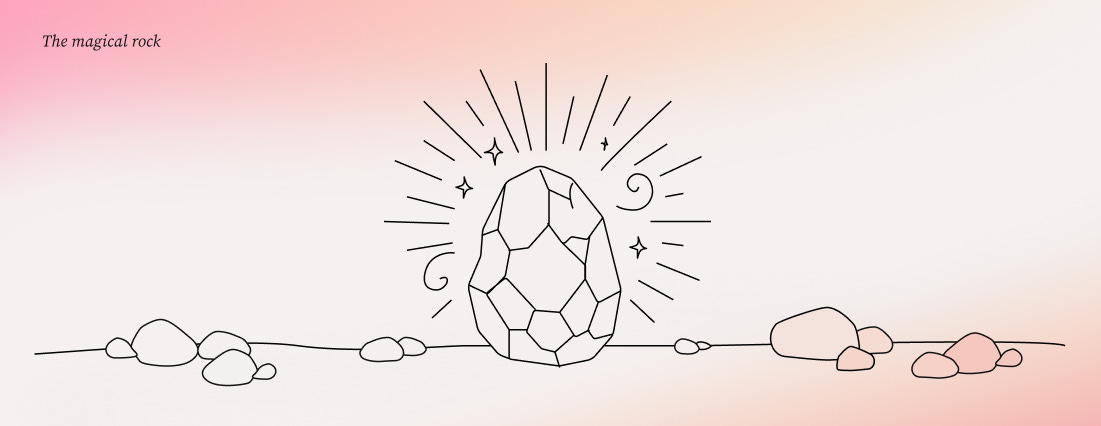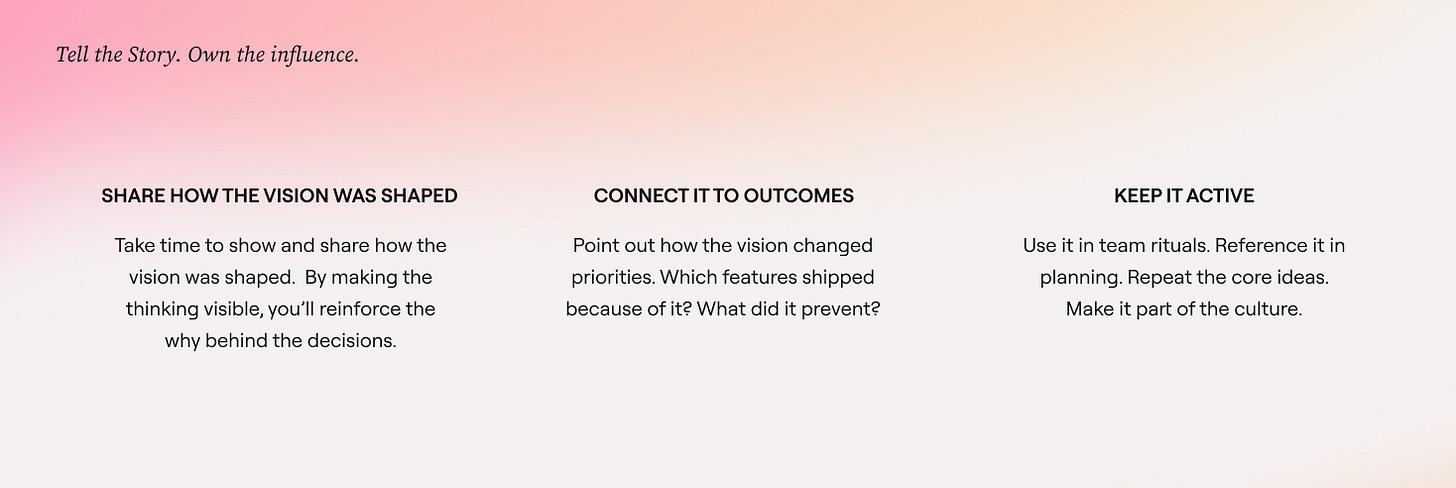Here’s a product development scenario: a bold vision is declared in a company meeting; the vision includes quotable statements about why it needs to happen, and how it will be transformative, disruptive, delightful, magical and an experience that everybody will love. People nod. Inspiration flows. Yet the question remains: “What does this actually look like in the product?”... Silence. One answer to this might be, “Let’s explore design solutions, we’ll know it when we see it.”
Congratulations, you’ve just been handed a classic “Go Fetch a Rock” task. In this phase, stakeholders have an exciting vision in mind that they cannot yet articulate. They expect you, the design leader, to shape that vague idea into something tangible. What is known intuitively is that the perfect rock exists and that they will know it when they see it.
Here’s how to play this game without needing to play this game. You set the frame, define the questions and turn all that ambiguity into direction.
Vision work is design work
Vision work requires the same depth of thought and intentionality as designing a feature interface or user flow. A strong vision answers:
What change are we creating in users’ lives?
What will they feel, do or achieve that they couldn’t before?
What does success look like, experientially?
Vision is about the future state of the product and the user’s experience in it. It’s the story of what your product will mean for people if you succeed.
A prototype built from a well-defined strategy, can show the path forward and rally others around the idea. But a prototype alone doesn’t clarify strategy. Churning out a quick prototype without a solid vision is like wandering without a compass. With the recent tools, designing and coding with AI; any maker can build faster than ever, still speed without direction will still mean getting lost faster. What differentiates strong teams is how deeply they think before they build.
Speed has never been the factor that makes a product great;
it’s the clarity of thought and precision behind what you build and why.
Great vision work is structured
It’s tempting to think great product visions emerge from a sudden late-night epiphany or the genius of one individual. In reality, meaningful vision work is structured and collaborative. It thrives on clear constraints and teamwork.
Before diving into a vision exercise, first check whether it’s even the right time to do it. There are moments in a company’s life when broad vision work can be counterproductive. Know when not to do vision work:
You’re mid-pivot and fundamentals shift weekly
Regulatory constraints dictate most decisions
Leadership and Org structures reset quarterly
The company is in crisis or survival mode. It needs delivery, not exploration.
How vision work fits into planning cycles
Vision work clarifies your roadmap or OKRs, it doesn't replace them. It serves as a filter for prioritisation. If you establish a shared understanding of where you’re going, quarterly planning will be faster because you’re choosing paths, instead of debating priorities.
Laying the Groundwork: How to Start a Vision Project
1. Set team and timeframe
Start by forming a small, cross-functional group. Include a design lead, a PM and an engineer. When sharing outcomes, have this group present as one team. They are collaborators, not stakeholders of one another.
Time-box the divergent phase. Limit early exploration to 2–3 weeks to avoid endless wandering. A fixed deadline drives sharper decisions and forces momentum.
Make the business case for this work and frame it clearly: “We’re spending 3 weeks now to avoid 6 months of misdirection later.”
2. Align on the experience goals first
What user problem/need are we solving?
What should people feel or accomplish?
What’s the horizon we’re aiming for? Are we envisioning something for the next 6–12 months, or painting a picture that’s more speculative and long-term? becomes your North Star. Keep the team focused here before debating solutions.
This is your North Star. Keep the team focused here before debating solutions.
3. Connect experience goals to business goals
If you deliver this experience, what will it do for the business?
Maybe it boosts retention, opens new markets or builds brand value. These connections surface critical assumptions, shape testable and measurable hypotheses that will align teams on why the vision matters.
4. Prototype fast and build shared understanding
Prototype to explore and test, not to pitch. This is a perfect moment to leverage AI tools for building. Feedback can start small and scale. In discussions, help the team focus on insights rather than opinions. You’ll invite more useful feedback at this stage if the ideas being presented don’t feel final and you can bring that feedback together into a shared understanding of what really matters.
Diverge with purpose, and converge with criteria
Exploring and expanding options is easy. Narrowing those options takes work. When stakeholders share a vague goal and aim for ideating lots of options, hoping something sticks, it can seem collaborative. But it’s often a way to avoid hard alignment. It delays the moment where someone must say: this is the direction and here’s why. As a design leader you need to create the space that allows your team to explore with purpose. And then converge with criteria that guides them toward a decision.
Create the space to diverge with purpose and converge with criteria.
At this phase, stakeholder feedback that is vague will lead you to chasing that mythical rock again. Now, the stakeholder likely has a strong intuition of what this rock is, does and looks like. They want you to either find it or, ideally, find something that is better than they imagined it would be. This is valuable information, an input like user insights or data. It’s the perfect moment to guide the discussion and reframe it into a more actionable conversation, with questions like these:
Let’s clarify, what do we want users to be able to do here that they can’t do today?
Which user problem are we solving with this concept, and is that the most important problem to solve right now?
If we made this experience ‘magical’, what specific improvement or outcome does that mean for the user? Let’s define magical in terms of user benefit.
When leaders don’t align
Sometimes, the toughest part of convergence is that stakeholders fundamentally disagree on what the vision should be and no one has called it out yet. This conflict can paralyse a vision exercise if not addressed.
Don’t get caught in the middle or pick a side. Instead, surface the underlying assumptions and make them testable. Treat each executive viewpoint as a hypothesis. Make the conflict visible by asking “What would have to be true for each to succeed?” This will help sequence decisions and efforts.
How to move from vision to reality
Once you've aligned on the vision, your role as a design leader will shift to becoming the translator and shepherd for execution.
Assign ownership
Map parts of the vision to teams and break that into shippable pieces.
“Which team will own implementing this part of the vision?” and “What’s the first tangible thing we can build and ship to start moving toward the vision?”
Translate the vision
Use stories or future-state examples, and avoid slogans. Help teams see how their work fits into the big picture. Your job is to scale clarity. Make sure everyone understands the why and what of the vision. Do not enforce a particular how.
Keep the essence, adapt the details
You will need to compromise, you will need to adjust, you will need to cut. Execution inevitably encounters technical constraints, timeline pressures and new learnings that will refine your thinking. Your information will often update in real time, from user testing, technical discovery, or market changes. The important thing is to keep the core experience goals, the essence of the vision, front and center while allowing flexibility in how they are achieved.
Track the impact
Create checkpoints in the execution cycle. Is your vision delivering:
Faster decisions
Less rework
Higher confidence
Real user benefits
Tell the Story. Own the influence.
Here’s a mistake I’ve seen and made myself: Design teams step back after creating a vision and expect the good work to speak for itself. If you don’t regularly tell the story, people will miss the plot or invent their own. By communicating effectively, you ensure the vision work remains a guiding light that’s actively shaping decisions.
To maintain influence, the vision's story must be continuously told.
You and your team must become the storyteller and advocate for the vision.
Signs that your vision had impact:
Faster decisions, because the team has a clear filter
People reference the vision in meetings without being prompted
New feature ideas get evaluated against the vision’s criteria
The vision shows up in roadmap discussions and team rituals
Fewer meetings that spiral into subjective debates
Watch out for “Stakeholder theatre”
Stakeholder theatre is when it looks like big-think work is happening, but in reality it is more show than substance. Here are a few warning signs:
You’ve produced glossy presentations, prototypes or documents that get multiple thumbs up, but are never again referenced in day-to-day work.
The vision work has gone on longer than it would take to actually build and ship something.
Months after the “vision” is supposedly decided, team members are still questioning or revisiting fundamentals in their work.
When vision is grounded in user insight, feedback, assumption or hypotheses it can be iteratively tested, fast-moving while anchored in reality. This will establish credibility. Teams will see it as a tool for clarity and progress, not performance or theatre.
When vision work fails
Sometimes the work doesn’t land, it doesn’t ship, and all artefacts are cast into an archive marked “not yet”. Emerging from that very real disappointment are learnings, critical tensions, clarified trade-offs and questions that will make your team better once they have been asked and faced head on:
Why didn’t the vision land?
What part wasn’t clear, adopted or actionable?
What does this say about where we are as a team, company, culture, industry
Then try again, smaller. Don’t give up. This work compounds.
If your organisation isn’t ready
You might be reading this and thinking, “This sounds great, but my company just isn’t into this kind of design-led vision work. That’s OK, organisational readiness for vision work varies and you can help build it over time.
If you sense vision work is needed but the culture isn’t there yet, try the following:
Start small. Run a vision sprint for one feature or flow. Solve a nagging user problem with a future-looking experience. Treat it like a pilot.
Find allies. Partner with PMs or engineers who value clarity. When it’s not a solo design effort, it’s easier to create the ripple effect.
Show the results. If your sprint prevented rework, clarified direction or saved weeks of dev time, tell that story. Share the impact in retros, planning docs, or team updates.
Be patient. Culture change is slow. A few small wins build your credibility. Enough wins build momentum.
Final Reflection
"Bring me something awesome!" is a phrase likely to endure in various forms, a testament to humanity's enduring hopefulness, imagination and creativity. You can play along with games like “Go fetch a rock”, or you can lead by reframing the task, and defining the problem.
Design leadership is about facilitating clarity and shared purpose. It’s about helping your team and company understand not only what to build, also why it matters. When you do that, you’re no longer fetching rocks, you’re pointing the way to the mountain.
I put together a playbook to guide your next “fetch a rock” moment.






